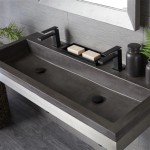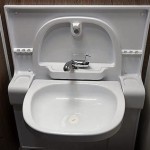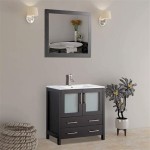Bathroom Vanity Height With Vessel Sink And Cabinet
Choosing the right bathroom vanity involves considering several factors, including the sink type, storage needs, and overall bathroom aesthetics. Vessel sinks, with their above-counter design, introduce a unique element to vanity height considerations. This article explores the interplay between vanity height, vessel sink dimensions, and cabinet design to help achieve a comfortable and functional bathroom space.
Key Considerations for Vessel Sink Vanity Height
Standard vanity height for a traditional sink is generally between 30 and 32 inches. However, vessel sinks sit above the counter, altering the functional height. This necessitates a lower vanity base to maintain a comfortable user experience. Several factors influence the ideal vanity height for a vessel sink:
* Vessel sink height and shape * User height and preferences * Countertop thickness * Faucet height and style * Overall bathroom design and available space * Plumbing considerations * Accessibility requirementsDetermining the Right Vanity Height
Calculating the appropriate vanity height for a vessel sink requires careful consideration of the combined height of the vanity cabinet, countertop, and vessel sink. The goal is to achieve a rim height, the distance from the floor to the top edge of the sink, that facilitates comfortable use. A general guideline for a comfortable rim height with a vessel sink ranges between 31 and 35 inches.
Impact of Vessel Sink Shape and Size
Vessel sinks come in a wide array of shapes and sizes. A shallow, bowl-shaped sink will require a different vanity height than a tall, cylindrical one. The depth of the sink directly influences the rim height and therefore the optimal vanity height. Taller vessel sinks typically require shorter vanity cabinets to maintain a suitable overall height.
Countertop Thickness and its Role
The countertop material and thickness also play a significant role in determining the final vanity height. Thicker countertops raise the vessel sink, impacting the overall rim height. Therefore, when using a thicker countertop, a lower vanity cabinet may be necessary. Conversely, a thinner countertop might allow for a slightly taller vanity base.
Faucet Selection for Vessel Sinks
Faucet selection is crucial for vessel sinks. Given their above-counter placement, standard faucets are often unsuitable. Specific vessel sink faucets are designed with higher spouts to accommodate the elevated sink basin. Wall-mounted faucets are another popular choice, offering a sleek and modern look while providing adequate clearance. The height and style of the faucet must be considered when determining the overall vanity height.
Cabinet Design and Storage Solutions
The vanity cabinet provides essential storage space in the bathroom. With a lower vanity height for a vessel sink, optimizing the cabinet's interior becomes even more important. Clever storage solutions, such as drawers with organizers and adjustable shelves, can maximize the available space. The cabinet design should also complement the overall aesthetic of the bathroom.
Ergonomics and Accessibility Considerations
Ergonomics play a vital role in bathroom design. The vanity height should allow users to comfortably perform daily tasks without straining or bending excessively. For individuals with mobility limitations or accessibility requirements, adhering to ADA guidelines is essential. These guidelines specify specific height ranges for accessible bathroom fixtures to accommodate wheelchair users and individuals with other needs.
Plumbing Considerations for Vessel Sinks
The plumbing for a vessel sink differs from that of a traditional undermount or drop-in sink. The drainpipe and supply lines must be carefully positioned to accommodate the above-counter placement of the vessel sink. During installation, ensure adequate clearance for the plumbing components and proper sealing to prevent leaks.
Maintaining a Cohesive Bathroom Design
The vanity, including the vessel sink and cabinet, should integrate seamlessly into the overall bathroom design. Consider the style of the vanity, the materials used, and the color palette when selecting the appropriate height and design. A well-designed vanity can enhance the aesthetics and functionality of the bathroom space.
Variety of Vessel Sink Materials
Vessel sinks are available in various materials, each contributing to the overall design and maintenance requirements. Popular materials include:
* Glass: Offers a sleek and modern look but requires careful cleaning. * Ceramic: Durable and easy to clean, available in a variety of colors and finishes. * Stone: Provides a natural and luxurious feel but can be more porous and require sealing. * Metal: Offers a unique and contemporary aesthetic but can be prone to scratches.Professional Installation Recommended
While some homeowners may choose a DIY approach, professional installation is recommended for vessel sinks and vanities. Plumbers and experienced contractors can ensure proper installation of the plumbing, secure mounting of the sink, and accurate measurements for the optimal vanity height. This minimizes the risk of leaks, damage, and ensures a functional and aesthetically pleasing result.

What Is The Standard Bathroom Vanity Height Size Guide

Plan Your Bathroom By The Most Suitable Dimensions Guide Engineering Discoveries Vessel Sink Vanity Floor Plans Interior Design

What Is The Standard Bathroom Vanity Height Size Guide

36 Solid Wood Porcelain Single Vessel Sink Vanity Set With A Polished Chrome Faucet

Don T Make Your Vessel Sink Too High Designing Perfect House

What Is The Standard Height Of A Bathroom Vanity

50 Counter Height Bathroom Vanity Ek3e Sizes Vessel Sink Dimensions

Eclife 24 In W X 20 D 32 H Single Sink Bath Vanity White With Ocean Blue Vessel Top Orb Faucet And Mirror Bv102wh Vs104bu The Home Depot

What Is The Standard Height Of A Bathroom Vanity

What Is The Standard Height Of A Bathroom Vanity Sizes Vessel Sink







